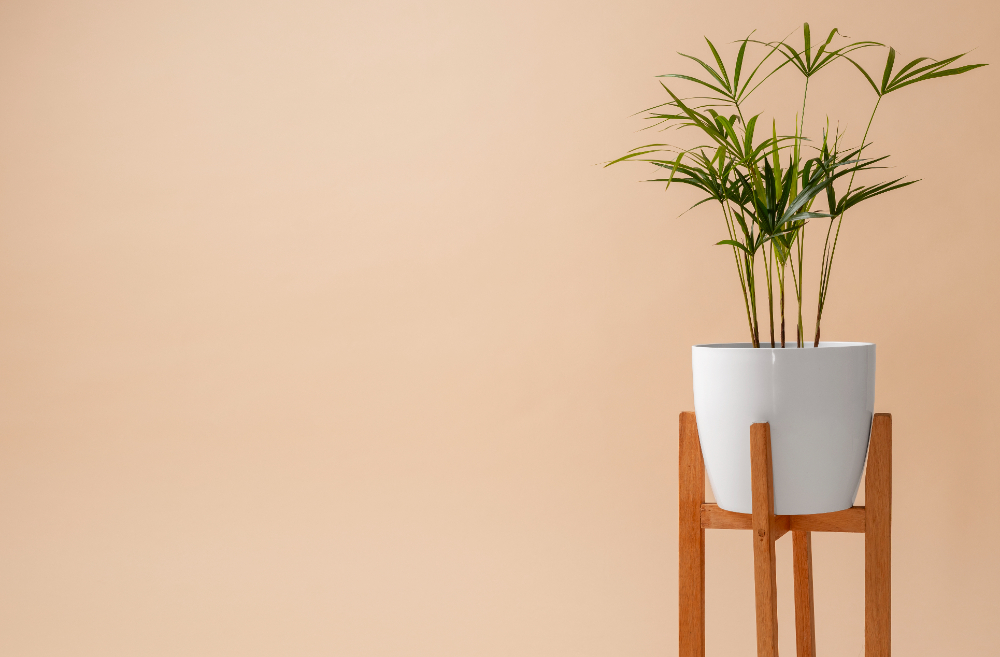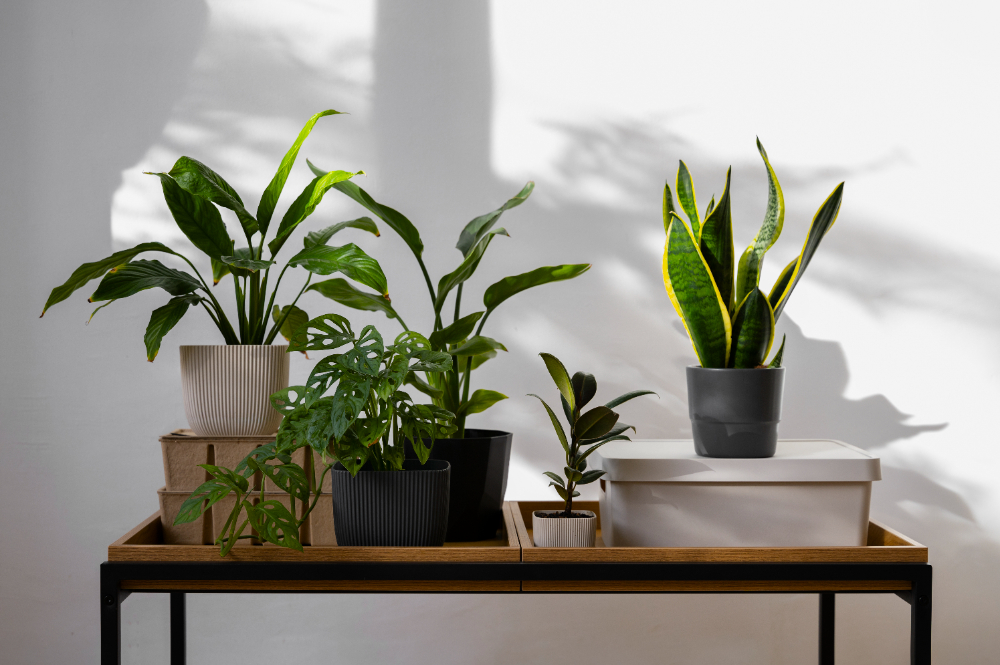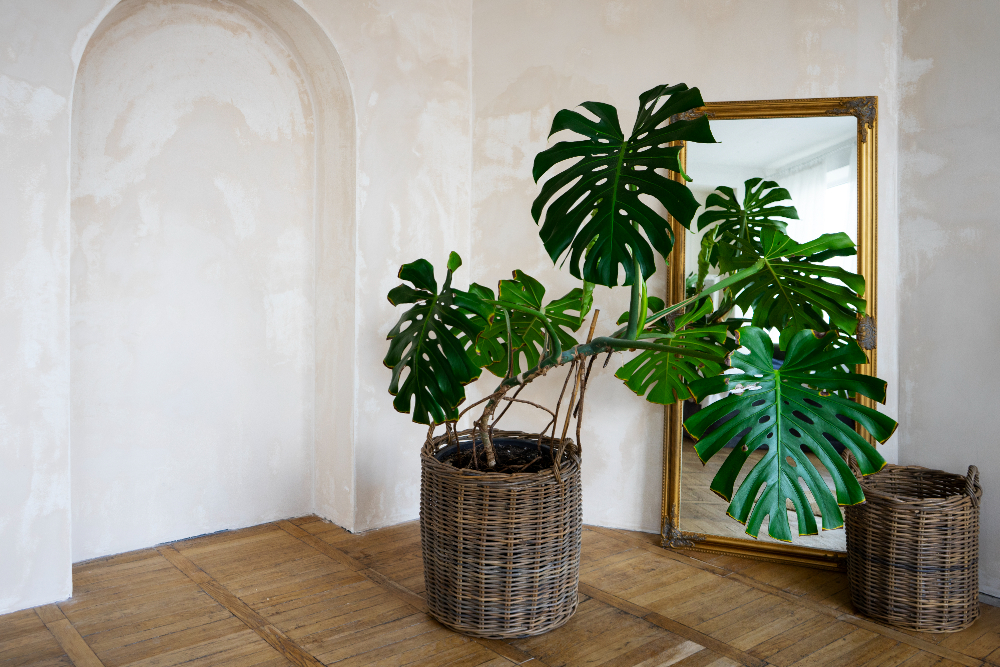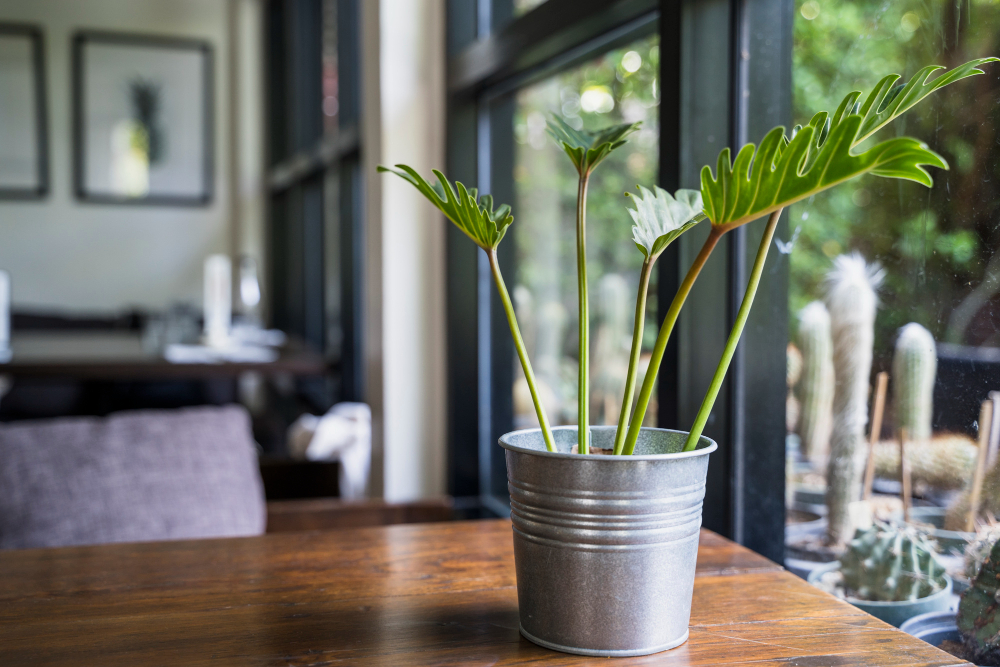Indoor plants have evolved beyond mere decorative items, transforming homes into lush, peaceful sanctuaries. Whether you’re aiming to improve air quality or create a more soothing, vibrant atmosphere, incorporating tropical plants into your interior decoration brings both aesthetic and health benefits. Living in a tropical or warm climate presents the perfect opportunity to seamlessly blend nature with interior spaces. Tropical plants thrive indoors, adding unique textures, shapes, and colors that breathe life into your home. From the bold leaves of Monstera to the elegant structure of the Fiddle Leaf Fig, these plants are not just visually stunning—they’re easy to care for and help create a relaxing environment.
In this article, we’ll explore the best tropical plants for indoor use and how these lush greens can enhance the beauty and functionality of your living space, transforming your home into a serene indoor oasis.

Why Tropical Plants are Perfect for Interior Decoration
Tropical plants are the ideal choice for indoor decoration due to their ability to thrive in environments that mimic natural indoor conditions—moderate temperatures, low light, and consistent humidity. Their resilience makes them particularly suited for those living in warm or tropical climates, but they adapt equally well to homes with indoor heating and air conditioning.
Incorporating indoor plants into your home not only adds aesthetic appeal, but also offers practical benefits that enhance your living space. Plants like Monstera, Philodendrons, and Fiddle Leaf Figs have become increasingly popular for their striking, sculptural leaves and ability to fill empty spaces with natural beauty. These plants make a bold statement, often becoming the focal point of a room with their large, lush leaves. Their organic forms soften interiors, bringing a sense of tranquility and vibrancy into any space.
Natural Beauty and Visual Impact
One of the main reasons to incorporate tropical plants into your home is their visual impact. Plants like the Monstera Deliciosa, with its large perforated leaves, can easily transform a dull corner into a striking focal point. The Fiddle Leaf Fig offers elegance with its broad, glossy leaves, perfect for making a statement in your living room or hallway. Philodendrons, with their rich green foliage, bring softness and warmth to a room, creating a welcoming atmosphere. The textured leaves of these plants add a unique visual dynamic that pairs well with minimalist or modern design.
Health and Well-Being Benefits
Beyond their aesthetic appeal, indoor plants contribute to a healthier indoor environment. Tropical plants like Philodendrons and Fiddle Leaf Figs are excellent at improving air quality by absorbing toxins and releasing oxygen, making your home fresher and more breathable. Additionally, they help maintain indoor humidity levels, which can reduce issues such as dry skin and respiratory problems, particularly in air-conditioned or heated environments.
Studies have shown that plants can also boost mood and reduce stress, making them a natural choice for creating a relaxing and calming environment. Their presence promotes feelings of tranquility and well-being, transforming your home into a peaceful retreat where you can unwind and recharge.
Whether you’re looking to fill a large, empty space or add small accents of greenery to your villa, tropical plants bring both beauty and functionality, enhancing the overall feel and atmosphere of your interior.
Ideal Tropical Plants for Indoor Use
Selecting the right tropical plants for your home is essential to cultivating a thriving, vibrant environment that adds both beauty and a touch of nature to your interior. These plants are not only stunning, but many are also well-suited for indoor life, offering easy maintenance while bringing a lush, tropical ambiance to your living spaces. Below are some of the best tropical plants to incorporate into your interior design.

Monstera Deliciosa (Swiss Cheese Plant)
The Monstera Deliciosa, also known as the Swiss Cheese Plant, is beloved for its large, eye-catching leaves with natural holes that give it a unique, tropical look. Its dramatic, perforated foliage can make any room feel more dynamic, making it a perfect choice for homes seeking a bold, natural statement. Thriving in indirect sunlight and adaptable to various indoor conditions, the Monstera is also relatively easy to care for, making it a favorite among plant enthusiasts.
- Aesthetic benefit: The broad, perforated leaves create a modern yet tropical touch, transforming your living space into a lush, contemporary retreat. Whether positioned in a bright corner or as part of a larger indoor garden, the Monstera is guaranteed to draw attention.
Bird of Paradise (Strelitzia)
Known for its exotic flowers and lush, glossy leaves, the Bird of Paradise adds an element of grandeur to any indoor space. While the plant’s vibrant orange and blue flowers are showstoppers, its large, arching leaves alone bring a dramatic and tropical feel to your interior. With the right care, the Bird of Paradise can grow tall, making it ideal for filling empty corners or adding height to a room.
- Aesthetic benefit: Its architectural structure and towering presence can bring life and elegance to any space in need of a vertical element. The plant’s glossy leaves also add a rich texture, offering both tropical charm and bold character.
Fiddle Leaf Fig (Ficus Lyrata)
The Fiddle Leaf Fig has surged in popularity over recent years, becoming one of the most iconic indoor tropical plants. It is admired for its large, violin-shaped leaves and its ability to complement a variety of interior styles, from modern to minimalist. This plant adds elegance and a touch of the outdoors to any room, often used as a natural room divider or accent piece.
- Aesthetic benefit: The glossy, broad green leaves create a sculptural element that enhances the modern or minimalist look of any room. Placed in a decorative pot or basket, the Fiddle Leaf Fig can serve as a statement piece, bringing both height and visual interest to your living space.
By incorporating these tropical plants into your indoor space, you’ll not only benefit from their lush, vibrant beauty but also enjoy a more inviting, serene atmosphere. Each of these plants adds its unique aesthetic charm while being relatively easy to maintain, making them excellent choices for anyone looking to enhance their home’s interior with natural elegance.
Enhancing Your Interior with Greenery
Adding indoor plants not only elevates the visual appeal of your home but also enhances the overall atmosphere by creating a natural sanctuary. The rich green hues and organic forms of plants contrast beautifully with modern materials such as wood, stone, or metal, offering a perfect balance to spaces filled with hard lines and angles. By strategically placing tropical plants, you can create a dynamic and inviting interior that feels fresh, alive, and harmonious. Here are a few ideas on how to maximize the impact of plants in your home:
Creating Plant Corners
One of the easiest ways to transform your home with greenery is by creating dedicated plant corners. This involves clustering tropical plants of different sizes, shapes, and textures in a specific area to create a mini-greenhouse effect. Mixing plants of various heights allows for a layered look that adds depth to your space. Tall plants like the Bird of Paradise or Fiddle Leaf Fig can anchor the corner, while smaller plants like Philodendrons or Pothos can fill in the gaps.
The combination of light and shadow created by different plant heights brings an added dimension to the room, making it feel more vibrant and dynamic. By positioning these plants near natural light sources such as windows or skylights, you can enhance their growth and vitality while creating a focal point in the room. This arrangement works beautifully in living rooms, bedrooms, or even bathrooms, where a splash of green can completely transform the ambiance.

Using Planters as Decor
The planters you choose for your plants can significantly influence the overall design and feel of the room. While the tropical plants themselves bring life and energy, the planters act as an extension of your interior style. Opt for neutral-toned ceramics or woven baskets to give your plants a grounded, natural look that blends seamlessly with various interior styles, from modern minimalism to rustic or coastal decor.
Hanging planters are another excellent way to introduce plants while saving floor space. These planters, often suspended from ceilings or walls, allow smaller plants like Spider Plants or Boston Ferns to thrive at eye level, creating a beautiful cascading effect. Alternatively, using plant stands elevates your plants, giving them a sense of importance while drawing attention to their intricate leaf structures. This is particularly effective in corners or areas where you want to add vertical interest without overwhelming the room with large furniture.
By combining thoughtful planter choices with lush greenery, you can enhance the overall design of your villa or home, ensuring that each element complements and elevates the other. Together, these elements help create a harmonious, natural, and elegant living environment.
Benefits of Indoor Plants Beyond Aesthetics
While the visual appeal of tropical plants is undeniable, their advantages extend far beyond decoration. Incorporating indoor greenery into your home not only enhances its beauty but also brings several functional and health benefits. Here are some key reasons why indoor plants are an essential addition to any home:
Improving Air Quality
Certain tropical plants are known for their remarkable ability to purify the air by absorbing toxins and releasing oxygen. Plants like the Peace Lily, Snake Plant, and Spider Plant are particularly effective at reducing harmful substances such as formaldehyde, benzene, and carbon monoxide from the air. By adding these air-purifying plants to your living space, you create a healthier environment for yourself and your family.
Snake Plants and Spider Plants, for instance, are known for their low maintenance and ability to thrive in low light, making them perfect for indoor settings. The Peace Lily not only cleans the air but also helps maintain humidity levels, preventing dry air in air-conditioned homes, which can improve overall respiratory health.
- Benefit: Reduced pollutants and improved indoor air quality create a fresher, more breathable environment, contributing to overall well-being.
Boosting Mood and Reducing Stress
Beyond the physical benefits, indoor plants can have a profound impact on mental health. Numerous studies have shown that the presence of plants in your home can significantly reduce stress levels and enhance overall mood. The calming effect of seeing lush, green leaves, combined with the soothing task of caring for plants, promotes relaxation and mindfulness. Whether it’s watering, pruning, or simply observing their growth, plants provide a therapeutic escape from the fast pace of everyday life.
Incorporating plants into high-traffic areas like the living room or office can create a more inviting and peaceful atmosphere, while placing them in spaces like the bedroom promotes a calming environment conducive to rest and relaxation. In this way, plants help turn your home into a tranquil retreat where you can unwind and enjoy a moment of serenity amidst the greenery.
- Benefit: The natural presence of indoor plants improves mental well-being, offering a relaxing and stress-reducing influence that promotes a sense of calm.
Conclusion
Using plants to decorate your interior provides both aesthetic and functional benefits, transforming your home into a vibrant and peaceful retreat. Whether it’s the tropical elegance of the Monstera or the bold structure of the Bird of Paradise, these plants breathe life into any room, enhancing not only its visual appeal but also improving air quality and creating a calm atmosphere. Carefully selecting tropical plants that thrive indoors and complement your existing decor ensures that your home feels balanced, refreshing, and in harmony with nature. With the right plants, you can turn your living space into a true indoor oasis—a place where beauty and tranquility coexist.

Faq
Plants like Monstera Deliciosa, Fiddle Leaf Fig, and Bird of Paradise are ideal for indoor use because of their adaptability and aesthetic appeal.
Most tropical plants prefer indirect light, regular watering, and moderate humidity levels. It’s essential to avoid overwatering and ensure they have proper drainage.
Yes, plants like Snake Plant, Spider Plant, and Peace Lily are known for their ability to purify the air by removing toxins and releasing oxygen.
Philodendrons, ZZ Plants, and Snake Plants are low-maintenance options that thrive with minimal care.
To prevent plants from dying, ensure they get the right amount of light, water, and humidity, and avoid overwatering or placing them in direct sunlight if they prefer indirect light.
Indoor plants benefit from general-purpose houseplant fertilizers during their growing seasons, typically in spring and summer.
Some plants, like ZZ Plants and Snake Plants, can thrive in low-light environments, making them perfect for rooms with minimal natural light.
Use ceramic, woven, or metal planters that complement your interior design. Make sure they have proper drainage holes to prevent root rot.
Create a mix of heights and textures by clustering plants in one corner or placing them on stands to make the room feel more dynamic and organic.
Some tropical plants can adapt to air-conditioned environments, but they may require additional humidity or care to thrive, such as regular misting.
